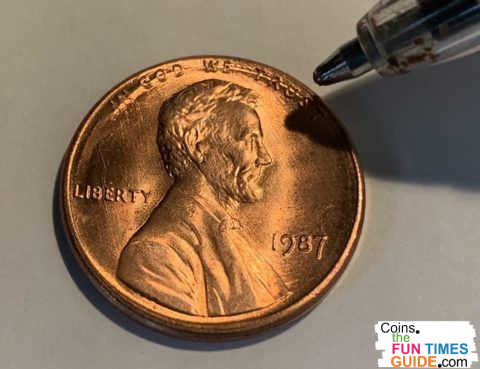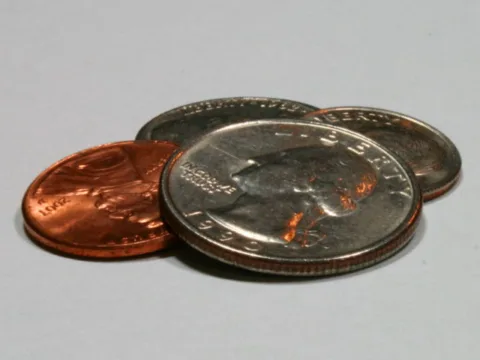A die clash is a type of error coin that occurs when two coin dies — the obverse and reverse dies — come together without a coin between them.
Die clashes occur every now and then. When the United States Mint notices this problem, the dies are fixed or replaced and coin production resumes as usual.
Because a die clash involves the dies impressing an image (or part of an image) on each other, the coins struck from clashed dies can sometimes show odd shapes on the designs.
Die clashes, or die clash error coins, can range in value based on the level of interest or following among a particular type of die clash error.
How Do Die Clash Error Coins Happen?
So, we mentioned that die clashes are created when a paired obverse and reverse die collide without a blank coin (or planchet) in between. This could happen when a planchet fails to enter its press chamber.
When the two opposing dies strike each other, damage is likely to arise on each of them. This creates marks on the opposite die.
However, the degree to which the die damage occurs will vary:
- Some clash marks, which would transfer to all coins struck by the damaged dies, are relatively minor in scope.
- In other cases, the damage is much more drastic.
What Do Die Clash Coins Look Like?

Some of these clash marks create popular errors — such as the so-called Prisoner Penny. These cool coins, showing the Lincoln Memorial columns from the reverse flanking Abraham Lincoln, often sell for $15 or more.
Other die clash errors exhibit other interesting images that evoke whimsical names from coin collectors — and some of them sell for decent premiums. The higher values reflect the larger number of collectors who pursue the more widely collected errors.
What Are Die Clash Error Coins Worth?
The die clash marks may be replicated on multiple coins until the affected dies are replaced. For this reason, along with the relatively frequent occurrence of die clash errors, die clash error coins aren’t necessarily scarce.
However, drastic die clash errors are both rare and valuable.
Die clash errors are scarce as a category — some are unique, and others exhibit marks that rarely occur.
As with most error coins, there isn’t a fixed price or a set book value for any and all die clash errors. This makes blindly giving your coin an accurate value estimate quite tricky — especially without the aide of a photo.
However, there are some basic price guidelines that can help you determine what your error coin might be worth. Here’s a rundown on die clash coin values.
These prices represent a typical value range above the coin’s regular value:
- Light die clash, minor transfer of additional detail — $3 to $10+
- Moderate die clash, more prominent transfer of other die details — $7 to $25
- Heavy die clash, drastic appearance of opposite die’s design — $20+
*Use of the terms “light,” “moderate,” and “heavy” here refer to the magnitude of the die clash marks. This can be determined by how much of the coin’s design or fields are interrupted by the additional elements. The strength of these additional elements, regardless of their size, also factor into the price of the coin.
Must read: Rare Coins vs. Scarce Coins: What’s The Difference?
Where To Find Die Clash Coins
Maybe you’re reading this article because you’ve found a die clash error — or a coin that you suspect is one.
These errors can be found virtually anywhere, including:
- your pocket change
- rolls of coins from the bank
- even estate sales
Another good way to find a die clash coin is to carefully search your coin dealer’s inventory. Cherrypicking for die clash errors is a great way to find some neat errors without having to pay more than ordinary prices!
Many coin dealers simply don’t look for die clash errors. Or, often the clash marks are too small to be seen without carefully looking across the coin’s surfaces with a patient eye and a 5X coin loupe.
Be sure to check all over the coin and particularly the fields, where clash marks are usually most prominent.
The Difference Between A Die Clash Error & Post-Mint Damage
Not sure if what you have is a real die clash error or a coin with post-mint damage (PMD) from being pressed or hammered by another coin?
On die clashes, the design from the opposite die will appear mirrored and incuse (struck into the surface). This is sort of like what happens when somebody hammers one coin onto another — the details of the other coin are transferred into the surface, with a reverse or mirrored appearance.
But there are a few key differences between PMD caused by hammering two coins together and a legit die clash error:
- A die clash always shows the design elements from the opposite side of the coin. In other words, you’re not going to find a Lincoln penny die clash with design elements from a Roosevelt dime or Washington quarter.
- Die clashes generally appear as softer, more ghost-like design transfers. These additional designs don’t usually show up with steeply incused, sharp borders.
- The clash marks will show up on the coin’s fields and perhaps other very low, broad surfaces. When the clash occurs, the opposite die’s deepest recesses are protected — and these deep recesses create the highest parts of a coin’s design. Therefore, you won’t see these clash marks on places like Lincoln’s cheeks on the penny, Jefferson’s ear on the nickel, or the torch on the Roosevelt dime. PMD on a hammered coin occurs in the opposite fashion — the design elements from the other coin will be mostly found on the higher parts of your coin.
Still in doubt? Bring a coin you think shows signs of a die clash to a knowledgeable coin dealer. He or she can also tell you the value of your coin, based on that sight-seen evaluation.
I’m the Coin Editor here at TheFunTimesGuide. My love for coins began when I was 11 years old. I primarily collect and study U.S. coins produced during the 20th century. I’m a member of the American Numismatic Association (ANA) and the Numismatic Literary Guild (NLG) and have won multiple awards from the NLG for my work as a coin journalist. I’m also the editor at the Florida United Numismatists Club (FUN Topics magazine), and author of Images of America: The United States Mint in Philadelphia (a book that explores the colorful history of the Philadelphia Mint). I’ve contributed hundreds of articles for various coin publications including COINage, The Numismatist, Numismatic News, Coin Dealer Newsletter, Coin Values, and CoinWeek. I’ve authored nearly 1,000 articles here at The Fun Times Guide to Coins (many of them with over 50K shares), and I welcome your coin questions in the comments below!


